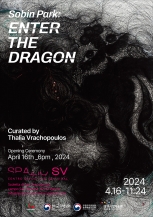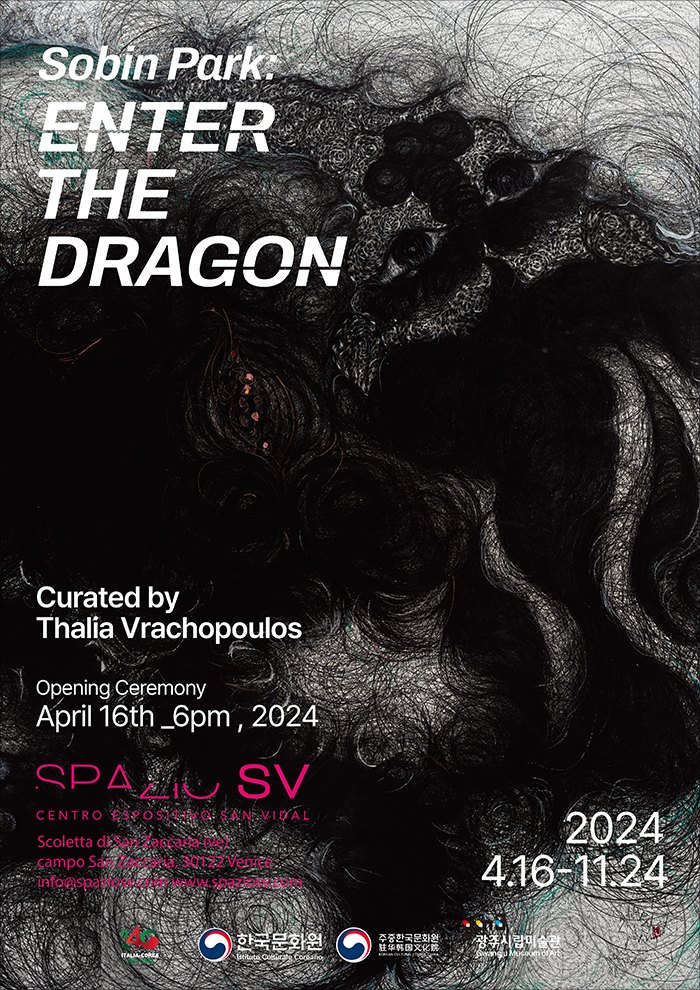박소빈: 용에 들어가다
■ 전시 개요
전 시 명 박소빈: 용에 들어가다
Sobin Park: Enter the Dragon
전시기간 2024.4.16.(Tue) - 2024.11.24.(Sun)
관람시간 10:30 am - 12:30 pm / 3:00 pm - 6:00 pm
* 월요일 휴관
오 프 닝 2024.4.16.(Tue) 6:00 pm
참여작가 박소빈 Sobin Park
전시장소 SPAZIO SV
Scoletta di San Zaccaria (ve)
campo San Zaccaria, 30122 Venice
문 의 info@spaziosv.com | +39 0415234602
베니스. 스파지오 SV는 뉴욕 큐레이터 탈리아 브라코풀로스가 주최하는 《박소빈: 용에 들어가다》 전시회를 자랑스럽게 선보입니다. 전시는 2024년 4월 16일부터 11월 24일까지 진행되며, 4월 16일 화요일 오후 6시부터 오프닝 리셉션이 열립니다.
《박소빈: 용에 들어가다》는 중국(동양) 점성술에서 상서로운 용의 해인 2024년에 열리는 전시로, 전설적인 무술가 이소룡이 주연한 1973년 로버트 클루즈의 영화 <용쟁호투 Enter the Dragon>의 제목을 적절하게 활용, 참조하고 있습니다.
이번 전시에는 박소빈의 예술적 상상력이 돋보이는 거대한 드로잉 작품이 전시되며, 강력한 용의 형태와 상징적인 여성의 모습을 신화적으로 묘사하여 용의 모든 유익한 속성을 상징하는 작품이 전시됩니다. 용은 동양 문화권에서 진화, 개선, 회춘, 풍요의 자비로운 선구자이자 수호신으로서 한국은 물론, 거의 모든 동양 문화권의 소중한 희망과 꿈을 신화적으로 구현하는 강력한 만물의 상징적 이미지로 정형화 되어있습니다.
박 작가는 끊임없이 변화하는 드로잉이라는 매체를 고찰하며 역사뿐만 아니라 현대미술의 광활한 영역과 창의적인 변증법을 통해 용 도상을 재탄생시킵니다. 그녀의 예술의 타고난 힘은 그녀의 예술적 실천의 탁월한 독창성에서 비롯됩니다. 작은 연필로 거대한 종이에 집요하게 그림을 그리는 박소빈의 작업 과정은 마치 최면에 걸려 춤을 추는 듯한 작가의 모습을 연상시키는데, 거대한 맥시멀리즘 화면에서 황홀하게 여기저기서 솟구치는 유연한 몸짓은 일종의 도교 의식을 수행하며 용을 활기찬 존재로 재창조하는 동시에 자신을 관능적인 여인로 재변모시킵니다.
Venice. Spazio SV a proudly presents the exhibition Sobin Sobin Park: Enter the Dragon organized by the New York curator Thalia Vrachopoulos. The show will run from April 16 to November 24, 2024 and will be celebrated with an opening reception on Tuesday, April 16 from 6 p.m.
Sobin Park: Enter the Dragon takes place during the 2024 auspicious year of the dragon in Chinese astrology, and appropriately but loosely references the title of the 1973 Robert Clouse film Enter the Dragon, starring the legendary martial arts Bruce Lee.
This exhibition includes Park’s immense drawings that comprise a special recollection of her artistic imagination; her powerful dragon forms, as well as the rippling depictions of her symbolic females, mythically betokening all the beneficial properties of the Dragon. As totems of a sui generis creativity, they function as symbolic images of the powerful creature, that mythically embodies the cherished hopes and dreams of nearly all Eastern cultures, that is, as benevolent harbingers of evolution, improvement, rejuvenation, and abundance.
Park considers the ever-changing medium of drawing, re-vitalizing the dragon iconography in a creative dialectic not only with historic, but also with the vast realm of modern and contemporary art. The innate power of her art springs from the exceptional uniqueness of her artistic practise. Obsessively drawing on her immense papers with a tiny pencil, Park’s process is reminiscent of a hypnotic dance, wherein her fluid gestures, ecstatically springing from here to there on the vast maximalist surfaces, perform a kind of Taoist ritual, virtually re-imagining the dragons into revitalized beings, while transforming herself into one of the sensual maidens.
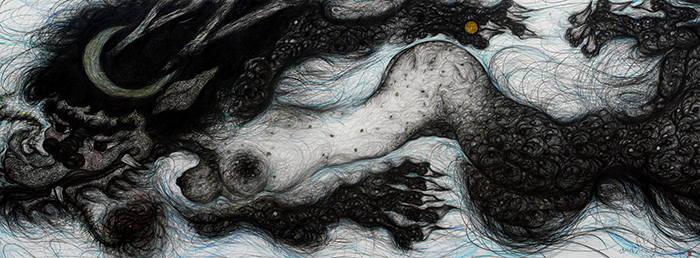
Seonmyo‘s Dragon - Tale of Buseoksa, 2018
pencil, bronze powder on paper 150 × 400cm
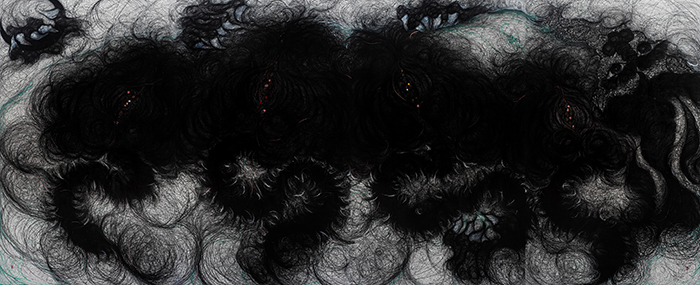
The New Myth, 2023
pencil, bronze powder on paper, 240 × 600cm, (4PS)

Creation of a New Female Myth, 2012
pencils on paper, bronze powder, 150 ×1300 cm

Heaven in love, 2023
pencil, bronze powder on paper, 245 × 600cm
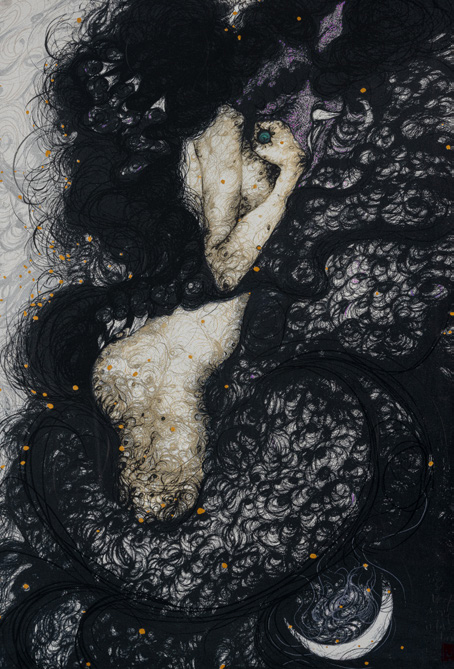
The Deep Dreams, Love2, 2009
silk engraving on paper, 250 x 150cm
Sobin Park: Enter the Dragon
By Thalia Vrachopoulos
This exhibition title refers to the 1973 Robert Couse film starring Bruce Lee as it, appropriately alludes to the imminent entry of the mythical Chinese dragon. The Western year of 2024 CE or the equivalent Jia Chen Year of the Chinese Calendar falls under the important sign of the wood dragon. This mythical creature firstly became an imperial symbol for the Chinese nation during the Song Dynasty (960-1279 AD). Many Chinese artists namely Dong Yu, Wu Huai, Ai Shu, Seng Fachang or the famous ink painter Chen Rong, who is mostly acclaimed as the pictorial father of traditional Chinese dragon iconography, began to specialize in artistic depictions of the legendary animal. While featured in numerous East Asian myths since the Han Dynasty (206 BC-220 AD) the dragon, as an emblem for the masculine forces of yang (such as in Chinese Goddess’ Nu Kua Creation story or in the Korean love-legend of Monk Uisang and the youthful maiden Seonmyo) - symbolizes divine nobility, almighty spirituality and the imperial will. Moreover, the dragon possesses shielding powers against evil spirits and mainly represents heavenly authority or the transcendental realm of Tian (天, while as a Chinese astrological sign, it is associated with rain and Shamanism.
In a way, the Year of the Wood Dragon is also the Year of Sobin Park. Since her art studies at Mokpo National University, Park’s idiosyncratic iconography of melancholy dragons and erotic maidens, has masterfully evolved into a repertoire of evanescent beings that effortlessly expand revitalizing with each new artwork, like the legendary dragons of Chinese mythology. Park’s comely maidens are mostly depicted entwined within the creature’s embrace, sometimes in the midst of metamorphizing from the dusky animal to a shining female or vice versa. In the context of Park’s imagery, the woman is the yin, which is combined with yang, i.e., the dragon, in order to ritually give birth to the Tao that interrelates all juxtaposing dualities of nature. Moreover, Park’s dragons are manifested as propitious, spiritual or benevolent creatures despite their terrifying and ghastly appearance. They stand thus in sharp contrast to Western artistic concepts, where dragons appear mostly as devilish and demonic creatures of unrelenting destruction. Her positive notion of the mythical animal is filtered though the intellectual lens of an Eastern-world-image, where, the awe-inspiring dragon is seen as a guardian spirit, and as a royal entity of unparalleled magnanimity. In the Eastern religious traditions of Confucianism, Buddhism and Taoism, the imaginary idol of the dragon represents a mystical manifestation of the divine otherworldliness on the terrestrial plane; according to H.C. Du Bose, the four dragons of the four corners of the earth are worshipped in times of deadly droughts (or other ecological disasters) in order to restore the divine balance and secure the wellness of humanity.
Considering the formal qualities of her art, one may say that Park’s oeuvre, ultimately constitutes an idiosyncratic offspring of Chen Rong’s artistic motifs and formal preoccupations. Park considers the ever-changing medium of painting/drawing, re-vitalizing the dragon iconography in a creative dialogue with the vast realm of modern and contemporary art. The innate power of her artworks springs from the exceptional uniqueness of her artistic practise. Obsessively drawing on her immense canvases with a tiny pencil in minuscule movements, Park’s painting process is reminiscent of a dhypnotic dance, wherein her flowing gestures, ecstatically springing from here to there before the vast surfaces of her maximalist images, unconsciously perform a kind of Taoist ritual, virtually re-birthing the dreary dragons into revitalized beings, while she transforms into one of her sensual maidens.
The exhibition at San Barnaba, in Venice during this year of the wood dragon, ultimately comprises a special recollection of Park’s artistic imagination; her powerful dragon forms, as well as the rippling depictions of her symbolist females, mythically betoken all the beneficial properties of the Wood Dragon. As totems of a sui generis creativity, they function as symbolic images of the powerful creature, that mythically embodies the cherished hopes and dreams of nearly all Eastern cultures, that is, as benevolent harbingers of evolution, improvement, rejuvenation and abundance
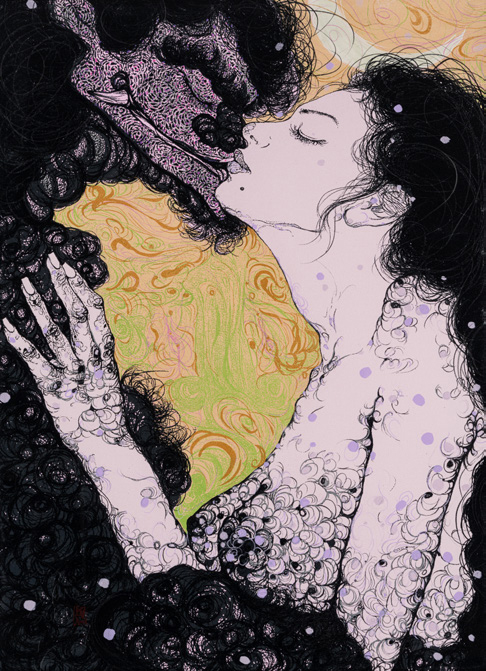
Kiss, 2023
silk engraving on paper, 106.5 x 81cm

Tale of Buseoksa - The Creation of New Myth 2017
pencil, bronze powder on paper, 145 x 1700cm
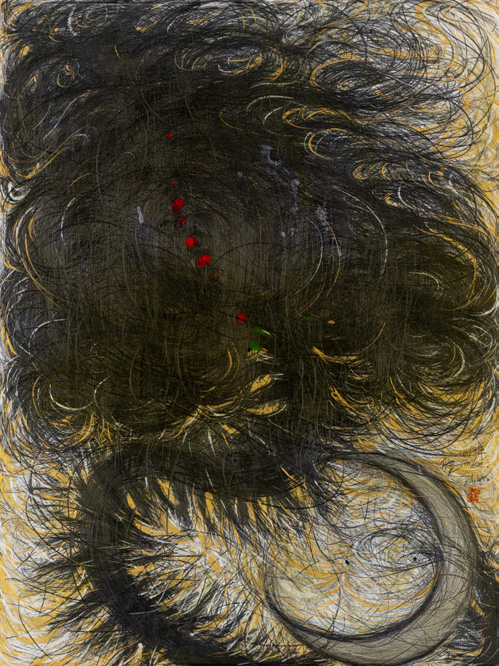
Dragon Flower 1, 2019
pencil, bronze powder, coloring, resin on paper, 121 × 91cm
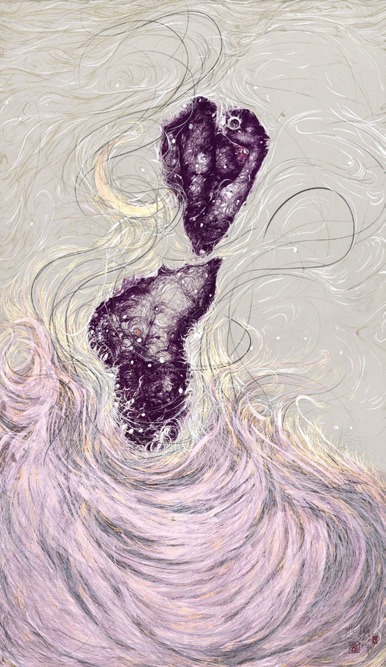
The Deep Dreams, Love1, 2013
Pencil drawing on silk engraving, 250 x 150cm
■ 작가 약력
박소빈 朴素赟 Sobin Park
박소빈(1971~)은 광주에서 태어나 목포대학교 미술학과, 조선대학교 대학원을 졸업했다. 1993년 광주 금호문화회관 개인전을 시작으로 뉴욕 텐리갤러리(2007), 뉴욕 첼시아트뮤지엄(2009), 뉴욕과 바르셀로나 가바론재단(2013), 아테네 크레타현대미술관(2015), 베이징 금일미술관(2017), 뉴욕 텐리 갤러리 NYC(2023) 등 30회 이상 개인전과 다수의 단체전에 참여했다. 2009년 광주시립미술관 하정웅청년작가 선정, 2014년 광주미술상 수상했으며, 2009년 브루클린의 부시윅 레지던시, 2011년 광주시립미술관 북경창작센터, 뉴욕 버몬트 레지던시 등의 프로그램에 참여했다. 현재는 중국을 거점으로 한국과 뉴욕, 유럽 등을 세계 곳곳에서 활발하게 활동하고 있다.
Sobin Park (1971~) was Born in Gwangju, Korea. She earned a BFA at Mokpo University and an MFA at Chosun University. Starting with her first solo exhibition in 1993 at Kumho Culture Center in Gwangju.
she has held more than 30 solo exhibitions at various galleries including Tenri Cultural Institute in New York (2007), the Chelsea Art Museum in New York (2009), the Gabarron Foundation in New York and Barcelona (2013), the Museum of Contemporary Art of Crete in Athens (2015) and Today Art Museum in Beijing (2017), Tenry Gallery NYC (2023), Gwangju Museum of Art / The Myth of Dragon (2024), Infiniyte Love. She has also participated in artist-in-residence programs supported by Bushwick Open Studios and Vermont Studio Center in New York. Since 2011, she has been active in many parts of the world, including Korea, New York, and Europe, based in China through the Gwangju Museum of Art’s Beijing residency program.

